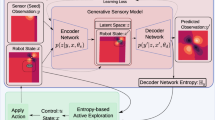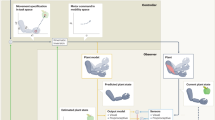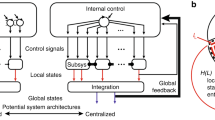Abstract
The notion that behaviour influences perception seems self-evident, but the mechanism of their interaction is not known. Perception and behaviour are usually considered to be separate processes. In this view, perceptual learning constructs compact representations of sensory events, reflecting their statistical properties1,2, independently of behavioural relevance3,4. Behavioural learning5,6, however, forms associations between perception and action, organized by reinforcement7,8, without regard for the construction of perception. It is generally assumed that the interaction between these two processes is internal to the agent, and can be explained solely in terms of the neuronal substrate9. Here we show, instead, that perception and behaviour can interact synergistically via the environment. Using simulated and real mobile robots, we demonstrate that perceptual learning directly supports behavioural learning and so promotes a progressive structuring of behaviour. This structuring leads to a systematic bias in input sampling, which directly affects the organization of the perceptual system. This external, environmentally mediated feedback matches the perceptual system to the emerging behavioural structure, so that the behaviour is stabilized.
This is a preview of subscription content, access via your institution
Access options
Subscribe to this journal
Receive 51 print issues and online access
$199.00 per year
only $3.90 per issue
Buy this article
- Purchase on Springer Link
- Instant access to full article PDF
Prices may be subject to local taxes which are calculated during checkout




Similar content being viewed by others
References
Olshausen, B. A. & Field, D. J. Emergence of simple-cell receptive field properties by learning a sparse code for natural images. Nature 381, 607–609 (1996)
Rao, R. & Ballard, D. Predictive coding in the visual cortex: a functional interpretation of some extra-classical receptive-field effects. Nature Neurosci. 2, 79–87 (1999)
Logothetis, N. & Sheinberg, D. Visual object recognition. Annu. Rev. Neurosci. 19, 577–621 (1996)
Goldstone, R. Perceptual learning. Annu. Rev. Psychol. 49, 585–612 (1998)
Mackintosh, N. The Psychology of Animal Learning (Academic, New York, 1974)
Lavond, D. G., Kim, J. J. & Thompson, R. F. Mammalian brain substrates of aversive classical conditioning. Annu. Rev. Psychol. 44, 317–342 (1993)
Thorndike, E. Animal intelligence: an experimental study of the associative processes in animals. Psychol. Rev. Ser. Monogr. Suppl. 2, 1–109 (1898)
Sutton, R. S. & Barto, A. G. Reinforcement Learning: An Introduction (MIT Press, Cambridge, Massachusetts, 1998)
Squire, L. & Kandel, E. Memory: From Mind to Molecules (Scientific American Library, New York, 1999)
Verschure, P. F. M. J., Kröse, B. & Pfeifer, R. Distributed adaptive control: The self-organization of structured behavior. Rob. Auton. Syst. 9, 181–196 (1992)
Verschure, P. F. M. J. & Voegtlin, T. A bottom-up approach towards the acquisition, retention, and expression of sequential representations: Distributed adaptive control III. Neural Netw. 11, 1531–1549 (1998)
Verschure, P. F. M. J. & Pfeifer, R. in From Animals to Animats: Proc. 2nd Int. Conf. Simul. Adapt. Behav. (Honolulu, Hawaii) (eds Meyer, J. A., Roitblat, H. & Wilson, S.) 210–217 (MIT Press, Cambridge, Massachusetts, 1992)
McFarland, D. & Bosser, T. Intelligent Behavior in Animals and Robots (MIT Press, Cambridge, Massachusetts, 1993)
Clancey, W. Situated Cognition: On Human Knowledge and Computer Representations (Cambridge University Press, Cambridge, UK, 1996)
Arkin, R. Behavior-Based Robotics (MIT Press, Cambridge, Massachusetts, 1998)
Pfeifer, R. & Scheier, C. Understanding Intelligence (MIT Press, Cambridge, Massachusetts, 1999)
Verschure, P. F. M. J. & Althaus, P. A real-world rational agent: Unifying old and new AI. Cogn. Sci. 27, 561–590 (2003)
Massaro, D. Perceiving Talking Faces: From Speech Perception to a Behavioral Principle (MIT Press, Cambridge, Massachusetts, 1997)
Mondada, F., Franzi, E. & Ienne, P. Experimental Robotics III: Proc. 3rd Int. Symp. Exp. Rob. (Kyoto, Japan, 28–30 October 1993) 501–513 (Springer, Berlin, 1993)
Tolman, E. Cognitive maps in rats and men. Psychol. Rev. 55, 189–208 (1948)
Bell, A. Levels and loops: the future of artificial intelligence and neuroscience. Phil. Trans. R. Soc. Lond. B 354, 2013–2020 (1999)
Sur, M. & Leamy, C. Development and plasticity of cortical areas and networks. Nature Rev. Neurosci. 2, 251–261 (2001)
Mehta, M., Barnes, C. & McNaughton, B. Experience-dependent, asymmetric expansion of hippocampal place fields. Proc. Natl Acad. Sci. USA 94, 8918–8921 (1997)
Houde, J., Nagarajan, S., Sekihara, K. & Merzenich, M. Modulation of the auditory cortex during speech: An MEG study. J. Cogn. Neurosci. 14, 1125–1138 (2002)
Rescorla, R. & Wagner, A. in Classical Conditioning 2. Current Theory and Research (eds Black, A. H. & Prokasy, W. F.) 64–99 (Appleton-Century-Crofts, New York, 1972)
Schultz, W. & Dickinson, A. Neuronal coding of prediction errors. Annu. Rev. Neurosci. 23, 473–500 (2000)
Kalman, R. A new approach to linear filtering and prediction problems. Trans. ASME J. Basic Eng. 82, 35–45 (1960)
Sanchez-Montanes, M., Verschure, P. F. M. J. & König, P. Local and global gating of plasticity. Neural Comput. 12, 519–529 (2000)
Acknowledgements
We thank A. Baumgartner and J. Manzolli for their support in performing the Markov analysis. Part of this research is supported by the Swiss National Science Foundation, the Volkswagen foundation and the Körber Foundation.
Author information
Authors and Affiliations
Corresponding author
Ethics declarations
Competing interests
The authors declare that they have no competing financial interests.
Rights and permissions
About this article
Cite this article
Verschure, P., Voegtlin, T. & Douglas, R. Environmentally mediated synergy between perception and behaviour in mobile robots. Nature 425, 620–624 (2003). https://doi.org/10.1038/nature02024
Received:
Accepted:
Issue Date:
DOI: https://doi.org/10.1038/nature02024
This article is cited by
Comments
By submitting a comment you agree to abide by our Terms and Community Guidelines. If you find something abusive or that does not comply with our terms or guidelines please flag it as inappropriate.



